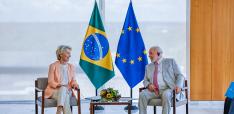Global Arms Control – Global Governance Futures 2025 interviews Kevin Körner
This interview was conducted for the ‘The Global Governance Futures 2025’ programme which brings together young professionals to look ahead and recommend ways to address global challenges.
MH & JS: What kind of uncertainties do political developments in rising powers/emerging markets pose to the future of global arms control in the coming decade?
KK: The proliferation of weapons to extremist non-state actors in war-torn regions and failed states is one of the most pressing challenges of our time. Importantly, proliferation does not necessarily need to be intentional. This is probably best illustrated by recent developments in Iraq and Syria. The unpredictably rapid advance of the radical militants of the Islamic State (IS) has been accompanied by their seizure of significant quantities of military equipment, including weapons of US origin that had been supplied to the Iraqi military. Even worse, there is a non-negligible risk that radicals could get hold of stockpiles of weapons of mass destruction (WMD) as some of the countries that suffer from persistent political instability and ethnic disputes also possess chemical or even nuclear weapons. Unintended proliferation could also become a matter of concern regarding unmanned technologies, as these appear to be vulnerable to hacking and hijacking.
The rise of robotic weaponry in the context of regional tensions in the emerging world is another pressing concern. We have intensively discussed implications of transferring decision-making processes to automated – or even autonomous – weapon systems; systems in which human control could be reduced to a minimum. One prominent threat we identified is the accidental triggering of military conflict through technical errors and malfunctions in the use of such weapons. While this risk is considered low between countries with healthy diplomatic relations, it could increase significantly in cases where inter-state tensions are already high, such as in East Asia, between China and Japan. Rapid advancements in developing robotic weapon technology and automation must therefore find adequate control and prevention mechanisms in a timely manner.
MH & JS: What types of financing are available for research related to robotic weapons? How do they influence or affect different types of research?
KK: Naturally, a bulk of research and development funding related to weapons technology comes from military and government agencies. Robotic weapons are no exception. Many advancements in robotics fall into the category of “dual use” technologies, such as unmanned vehicles that can be used for both military and civilian purposes. For example, an unmanned autonomous helicopter could be used for traffic control if equipped with a surveillance camera or, if armed, turned into a robotic weapon. Due to the vast range of potential civilian applications of unmanned vehicles and robotics in transport, logistics, agriculture, and even elderly care, the interest of private companies in this research has grown intensively over the last years. It is going to be a big market and therefore attracts a lot of money. Thus, private sector funding for robotics research is becoming increasingly important. This will also draw the research focus more towards civilian applications. It probably does not so much influence the different fields of robotics research in the arms industry as here research priorities are strongly driven by demand and requirements of the military. Links between the military and private sector will remain strong but there are also cases in which private companies are seeking to reduce military/government funding – and thus dependence on that funding – to concentrate on civilian use of their technologies.
MH & JS: Do you see current developments in robotic weaponry as intrinsically linked to America’s war in the Middle East?
KK: The issue of robotic weaponry and its impact on modern conflicts goes far beyond America’s involvement in the Middle East and South Asia. True, media attention has mostly been drawn to the use of armed unmanned aerial vehicles (UAVs) in US operations. The controversy has been especially strong when it came to civilian casualties in countries such as Yemen, Pakistan and Afghanistan. It is also true that the US used to have some kind of monopoly on unmanned systems about a decade ago. But the situation has clearly changed over the last years. Rising powers around the globe are increasingly seeking access to UAV technology for military purposes. According to a recent report by the RAND Corporation, 23 countries, including both industrial countries and emerging economies, are potentially developing armed UAVs. Experts have pointed out that a worldwide spread of UAVs within the next 10 years could be possible. Thus, while the US might be the leading force in research and development on robotic weaponry in the mid-term, other countries are catching up and they are likely to succeed, as they have so far for more strategically important technologies. To come back to your question: That the use of UAVs is often linked to US military efforts in the Middle East illustrates that warfare is currently undergoing major technological change – and these changes will not remain limited to the Middle East but affect international conflicts in general.
MH & JS: Coming from the private sector, how does your own approach to global arms control issues differ from/relate to the approaches of colleagues from government, international organizations and academia?
KK: Coming from the private sector does not strongly influence my view on global arms control issues. As a researcher and risk analyst, my interest in the issue of global arms control is primarily centered around how to avoid future conflicts and to analyze how international cooperation and legislation can mitigate and contain risks stemming from the spread of both new and already existing military technology.
For weapons of mass destruction binding frameworks are in place already, including the Treaty on the Non-Proliferation of Nuclear Weapons (NPT) or the Chemical Weapons Convention (CWC). Similarly, the use of some conventional weapons such as landmines has been restricted under the Convention on Certain Conventional Weapons (CCW). I think that most people – independent of the sector they work in – would agree that such frameworks should also exist when it comes to new weapon technologies that imply an increasing degree of automation and thus decreasing human control, as these developments bring along a variety of risks as well as legal and ethical questions. This is also my impression from the discussions in my GGF2025 working group, which comprises participants from government, international organizations, academia and the private sector.
Of course, all these issues are relevant for the corporate sector as well. For example, in case of fully autonomous weapons, who would bear the moral and legal responsibility in case of a (lethal) malfunction? Would it be the military that launched the weapon? The company that produced and sold the device? Or maybe the developer who programmed the machine’s algorithm? Given their global implications, these questions need to be addressed in an international framework. One promising step in that direction – and an indicator that the challenges posed by robotic weaponry are increasingly being taken seriously – was offered by the CCW Meeting of Experts on Lethal Autonomous Weapons Systems that took place at the UN in Geneva this May, and I hope that discussions continue along this trajectory.
Kevin Körner is senior economist and country risk analyst at Deutsche Bank Research and a Global Governance Futures 2025 fellow. The views expressed are those of the interviewees and do not necessarily represent the views of, and should not be attributed to, Deutsche Bank Research.


